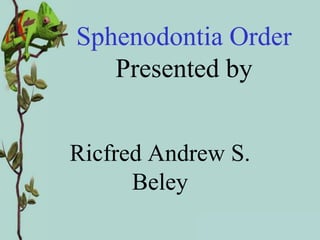The sphenodontia order
•Transferir como PPTX, PDF•
5 gostaram•4,430 visualizações
He is doing this for Team Reptile for their web quest project. Imagine he is only 6 years old doing this kind of stuff. Amazing Technology works for curious intelligent children.
Denunciar
Compartilhar
Denunciar
Compartilhar

Recomendados
Recomendados
Mais conteúdo relacionado
Mais procurados
Mais procurados (20)
Social organization and social behaviour in insects

Social organization and social behaviour in insects
Bird migration, Types of birds, Advantages and disadvantages of birds 

Bird migration, Types of birds, Advantages and disadvantages of birds
Pisces general characters and classification - copy

Pisces general characters and classification - copy
Destaque
Destaque (9)
Semelhante a The sphenodontia order
Semelhante a The sphenodontia order (20)
Último
Mehran University Newsletter is a Quarterly Publication from Public Relations OfficeMehran University Newsletter Vol-X, Issue-I, 2024

Mehran University Newsletter Vol-X, Issue-I, 2024Mehran University of Engineering & Technology, Jamshoro
Último (20)
HMCS Max Bernays Pre-Deployment Brief (May 2024).pptx

HMCS Max Bernays Pre-Deployment Brief (May 2024).pptx
Beyond_Borders_Understanding_Anime_and_Manga_Fandom_A_Comprehensive_Audience_...

Beyond_Borders_Understanding_Anime_and_Manga_Fandom_A_Comprehensive_Audience_...
On National Teacher Day, meet the 2024-25 Kenan Fellows

On National Teacher Day, meet the 2024-25 Kenan Fellows
Basic Civil Engineering first year Notes- Chapter 4 Building.pptx

Basic Civil Engineering first year Notes- Chapter 4 Building.pptx
This PowerPoint helps students to consider the concept of infinity.

This PowerPoint helps students to consider the concept of infinity.
Kodo Millet PPT made by Ghanshyam bairwa college of Agriculture kumher bhara...

Kodo Millet PPT made by Ghanshyam bairwa college of Agriculture kumher bhara...
21st_Century_Skills_Framework_Final_Presentation_2.pptx

21st_Century_Skills_Framework_Final_Presentation_2.pptx
ICT Role in 21st Century Education & its Challenges.pptx

ICT Role in 21st Century Education & its Challenges.pptx
The sphenodontia order
- 1. Sphenodontia Order Presented by Ricfred Andrew S. Beley
- 2. The sphenodontia order is the smallest order of reptiles from New Zealand.
- 3. Scientific Name Sphenodon punctatus and the much rarer Sphenodon guntheri
- 4. resembling mainly the lizard, and have been around since the end of the dinosaur era, 200 million years ago.
- 5. Size Males - can reach Females - less than more than 24 in 16 in (40 cm) in (60 cm) in length length and rarely and 2 lb (1 kg) in exceed 1 lb (454 weight. g) in weight.
- 6. Body Covering • The spiny plates on the back • Tail resemble those of a crocodile more than a lizard, but has the latter reptile's ability to break off its tail when caught by a predator, and then regenerate it. • The tail and back are covered with spiny plates • bony plates in the skin
- 7. Color - tan-colored lizard-like reptile that lives in New Zealand. - some are greenish brown
- 9. How many babies? •It takes the females between one and three years to provide eggs with yolk •up to seven months to form the shell. It then takes between 12 and 15 months from copulation to hatching. •lay 8 to 15 eggs •This means reproduction occurs at two- to five-year intervals, the slowest in any reptile. •eggs - have a soft, parchment-like shell.
- 10. • The sex of a hatchling depends on the temperature of the egg • with warmer eggs tending to produce males • and cooler eggs producing females. • Their babies are called Hatchlings
- 13. They move
- 14. Habitat • inhabit forest and pasture near seabird colonies. The preferred habitat is coastal broad-leaf forest, especially where seabirds have dug burrows. • low-growing, salt-tolerant trees that form a complete canopy over a relatively open forest floor
- 15. Cold Blooded Animal -Adult tuataras are nocturnal , but they will bask in the sun for heat.
- 16. How do they Protect themselves? • both sexes defend territories, and will threaten and eventually bite intruders. The bite can cause serious injury. Tuatara will bite when approached, and will not let go easily.
- 17. predominantly prey on • beetles, cricket s, and spiders. • Their diet also consists of frogs, lizards , and bird's eggs and chicks
- 18. Special Features • The tuatara has a third eye on the top of its head called the parietal eye • Their lungs have a single chamber and lack bronchi.
- 19. Additional Information • Status - vulnerable • Tuataras do not have ears, but they can hear. • The tuatara has been classified as an endangered species since 1895 • They hibernate during winter